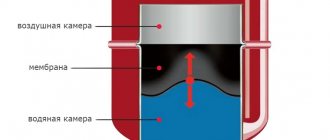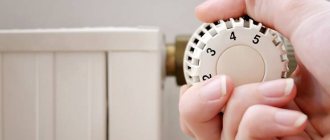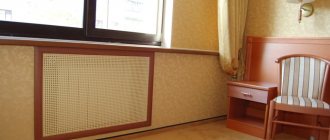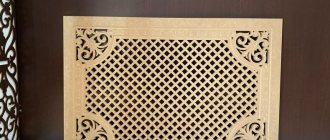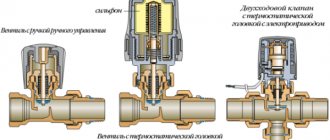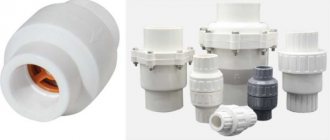Heating radiators have become a part of modern life. Invisible helpers warm our home, making it truly cozy and comfortable to live in. Cast iron, steel, aluminum, made of brass or copper - sooner or later they all take on a less than marketable appearance. In this case, despite some financial and thermal losses, the best option to hide visible flaws would be to purchase a protective screen for the heating radiator. The question immediately arises of what material or design to choose in order to eliminate heat losses as much as possible and not lose money on the price. The editors of Seti.guru, as always, have collected the most interesting ideas for decorating your home.
You can use the battery in this way, or you can come up with an interesting solution using a modern screen for the radiator
Why do you need a screen for a heating radiator?
A bad battery screen will shamelessly and brazenly steal your heat.
And you lose, first of all, heat. We all know how in Soviet times they fought a hot battery by simply covering it with a blanket. This was the first screen for a cast iron battery. The protective screen works on approximately the same principle. If heat loss is not too noticeable in summer, then in winter it can become a problem. That is why, before deciding to choose a screen for a heating radiator, it is very important to calculate the probable heat loss. In this case, it would be useful to study the distribution of heated air in the room where the radiator is installed.
The principle of heat transfer in a radiator battery
The battery's operation is based on the convection mechanism: warm air masses rise upward, and cold air masses go down.
Note! The correct radiator grille should direct warm air upward, thereby blocking the path of cold flows from the window. Grilles on the top panel or directional slits will help ensure such a flow.
Thus, when installing a radiator screen, it is always necessary to leave a gap for the intake of cold air, and ensure its unobstructed exit from above. The radiator's heat transfer will also depend on the width of the gaps and grille holes for the heating battery.
First of all, let's consider situations when installing a screen is necessary:
- If there are children in the house who can easily get burned by too hot radiators.
- Unsightly appearance of the radiator, but quite usable.
- If there are animals in the house that could get hurt by the battery, get stuck there or get burned.
- The radiator is too bulky.
- It is necessary to adjust the flow of warm air in the desired direction.
Features and purpose
According to building codes, heating radiators should be installed directly under window sills. Thanks to this, not only the air in the rooms warms up, but also provides protection against condensation on the windows. To do this, the design of the batteries should protrude slightly forward in relation to the window sills.
However, these requirements are not always met. In recent years, metal-plastic windows have been installed en masse. Often, sealed window structures are installed, and the window sills cover the radiators, interfering with the movement of air flow. This leads to the formation of condensation on the windows.
Other reasons for condensation on windows may be:
- high room temperatures;
- improper installation of window structures;
- high thermal conductivity of double-glazed windows;
- lack of ventilation in the room.
Many modern double-glazed windows provide a tight fit, resulting in air circulation being disrupted. Therefore, condensation may appear in the corners of windows, which is a favorable environment for the development of mold and harmful microorganisms.
The installation of ventilation grilles ensures the required air exchange, which eliminates the formation of condensation. They can be mounted on various types of window sills (plastic, stone or wooden). In this case, warm air from the radiators will rise, passing through the grilles to the windows. The cooled air will sink and also pass through the grilles, which will provide air ventilation in the room.
Modern standards for the construction of multi-story buildings take into account the possibility of including ventilation grilles in the design. But in most existing buildings you have to install the grilles yourself. In this case, it is necessary to choose the right place where they will be attached.
It is worth considering that convection grilles are considered an element of the interior
Therefore, when choosing a product, it is recommended to pay attention to its appearance.
The color of the grilles is also of great importance. Usually it is selected in such a way that it matches the color of the double-glazed windows. The most common are white designs. Steel grilles are often painted in gold or silver tones to create an original design.
Wooden gratings are rarely painted. Typically, wooden surfaces are coated with a special varnish. It protects the material from negative external influences. It must be remembered that some varnishes and paints can release toxic substances when heated. Therefore, you should choose a paint that is resistant to high temperatures.
Thanks to the grilles, an ideal microclimate is established in the room. Air circulation allows you to obtain optimal values of humidity and heat. In addition to improving indoor air ventilation and the possibility of decorating window sills, the main advantages of ventilation grilles include ease of installation and maintenance.
When choosing a grate, you should consider its length. It is recommended to choose a product whose length will coincide with the length of the radiator. In this case, the ventilation structure itself can be implemented in the form of a single element or can have several short-length grilles mounted in the window sill in series. If you install an insufficiently long grille on only one side of the window sill, then condensation will still appear on the opposite side of the window.
In addition to the length, an important characteristic of the lattice is its cross-section. It determines the area of the holes for air circulation
The optimal cross-section will be a value from 0.42 to 0.6, which will be an effective means of combating condensation on windows. The larger the cross-section, the more air the grille will be able to pass through.
However, in some cases, large holes may not be the best option. If you plan to put various things on the windowsill, then it is better to choose grilles with small holes, otherwise various small objects may fall through them.
Sometimes the grilles need to be replaced (if they become unsuitable for further use). It is also recommended to ensure that there are not many pots of indoor flowers on the windows. This is due to the fact that regular watering leads to the accumulation of condensation on the windows.
Battery screens: their advantages and disadvantages
With the help of radiator grilles, you can completely hide the radiator from human eyes and make even the most massive structures invisible to others.
In addition, the battery box reduces the risk of injury and burns to both people and animals. And the battery itself receives a protective case, which eliminates possible mechanical damage or chips. In addition, decorative grilles for heating radiators can change for the better the interior that is familiar to the eye.
This battery screen will hide all imperfections and will decorate the room.
If we talk about the disadvantages, these are, first of all, heat loss. However, this “trouble” can be overcome if you choose screen models with a large number of holes or large gaps.
Possibility of an alternative
If the budget does not allow, or there is no desire to choose a new interior detail, which, in any case, will require additional care efforts, the best replacement for the screen may be decorating the heating radiator itself.
The simplest method is painting with ordinary oil paint. At the same time, to achieve a camouflage effect, you can fit the battery, pipes and adjacent wall into a single pattern.
A standard radiator is a convenient object for realizing creative potential in your favorite style: it can be covered with a chintz pattern or a painting using decoupage and acrylic paints, or simply “aged” to match the loft style.
What are radiator grilles made of?
Wood, plastic, tempered glass, aluminum, cast iron and pressed slabs - this is the main list of materials that can be used in the manufacture of decorative screens for heating radiators.
Tree
Wooden grilles for a heating radiator are one of the most expensive screen options. Firstly, it is an environmentally friendly material, and secondly, it does not emit any toxic substances when heated. Typically, such grilles have a special non-flammable coating and are safe for installation in children's rooms and bedrooms.
Thanks to small gaps and good heat dissipation, such radiator screens can perfectly cope with the task of retaining heat on the one hand, and protect your child from burns and bruises, on the other hand. Such products are quite strong and durable. In addition, this material allows you to slightly expand the boundaries of the usual understanding of what a decorative grille for heating radiators should be.
The radiator screen can easily turn into a shelf for books and toys
But such beauty must be cared for carefully and treated with special compounds so that the structure does not “sink” due to excessive drying. There is a large price gap in the cost of such “masterpieces”: slatted variations can cost about 1,000 rubles, designs using natural wood, especially carved variations, can reach up to 6,000-7,000 rubles per piece.
Metal
Aluminum screens have become more durable and, naturally, have maximum heat transfer. Radiator grilles on a metal battery act as an additional heating element.
A special feature of the metal structure is the ability to apply designs to the surface of the screens or paint them, which simplifies the choice of design solutions. Such grilles can be either openwork or with uniform perforation; they can come in the form of an overhead grille or have a solid frame.
Glass
But glass for a decorative grille for a heating radiator is not the most popular option. Despite its versatility (any ornament, photo or image can be applied to this surface), glass is fragile and easily soiled. Glass screens for batteries are not a very good solution for families with small children, because even tempered glass can break if hit by a careless metal toy.
Glass can be frosted, colored, or transparent, with photo printing or sandblasting.
Plastic
This material is less environmentally friendly and has low thermal conductivity. Less durable than glass and wood, which is why multilayer technology for manufacturing such products is used in production. In addition, in case of strong heating, this material releases harmful substances, which is why plastic screens cannot be used in children's institutions.
Plastic screens are most often used to protect batteries from dust.
It is recommended to install such structures in utility rooms, shops, and domestic premises, where heat loss may not be so noticeable. Among the advantages are light weight, corrosion resistance, moisture resistance, and the ability to apply drawings.
MDF and HDF
MDF is a board pressed from wood chips. Quite fragile, but at the same time cheap material. The big disadvantage of panels of this type is chipping and shedding of corners and elements, as well as low moisture resistance.
At first glance, MDF boards cannot be distinguished from solid wood products
A more innovative version of MDF is HDF boards. Actually, these are also shavings, but the pressing process occurs at higher temperatures, the natural component ligin is released from the raw material, which, when heated, turns into organic glue, which binds the fibers into a dense layer.
Perforated HDF boards Example of a radiator grille made from HDF boards
Interesting fact! The density of HDF is from 800 to 1000 kg/m³, and MDF is only up to 800 kg/m³.
This material is more environmentally friendly and durable. This material is currently considered the optimal solution for covering radiators.
Popular solutions
Currently, there are many ways to hide old cast iron radiators under the window. Screens from a wide variety of materials, niches, painting, mounting into the wall - options for every taste. But if decorating heating radiators in a living room, bedroom or nursery is quite simple - just choose a solution that will harmonize with the overall style of the interior - then in rooms with characteristic conditions (for example, in the kitchen, bathroom) this is more difficult to do.
For these rooms, it is necessary to select a material that will withstand high humidity, temperature changes, and possible exposure to steam and chemicals. And with all this it will be non-toxic. The best option would be to paint the radiators to match the walls or in a contrasting color. This method of decorating pipes is the most common in bathrooms.
As for the other rooms of the house, everything depends solely on the imagination and budget of the owners. But the basic requirements for radiator screens must be met in any case. After all, their main task is to hide unsightly heating elements without compromising heat transfer. Therefore, any screen must provide free air circulation and IR radiation. At least create minor obstacles to this.
The now popular glass screens, of course, are highly decorative and look great in the interior, but they significantly reduce heat transfer, which means they help lower the temperature in the room. This decor can be used if heating is carried out in some other way, for example, using heated floors.
Quite often you can find such a solution - radiators are mounted inside the wall, and a small window (or two) is left behind a grill for the passage of heat. Not only does the temperature in the room drop significantly in this case, but also access to the system becomes almost impossible - to do this you will have to break the wall in the literal sense of the word.
The same applies to boxes made of plasterboard, plywood, MDF, chipboard and other similar materials. Reduced heat transfer, difficult access to the system versus decorativeness. Everyone makes a choice for themselves.
Screens made of metal – copper or aluminum – are now gaining popularity. Such models not only will not lower, but may even increase the temperature in the room. Heated by the radiator, such screens themselves act as a battery and additionally heat the room.
If the room is covered with wallpaper, the heating elements can be decorated using leftovers. By cutting them into strips and gluing them onto radiators (with heat-resistant glue, of course), you can get a wonderful decorative element that will harmoniously fit into the interior at minimal cost.
In a children's room, you can generally give free rein to your imagination, or you can involve the inhabitants of the room in the process. Children will happily take on the task of decorating their own home and will tell you how they would like to decorate the radiators. Favorite cartoons, fairy tales, your own imagination, in which the room is not a room at all, but a ship, a tank or a racing car. All this can be used when decorating radiators.
Types of radiator grilles for radiators
Related article:
Which heating radiators are best for an apartment. In a special publication, we will consider not only the types of devices, the criteria for the right choice, but also manufacturers, models, and useful tips.
Regardless of whether you make a screen for the battery with your own hands or install one purchased in a store, the installation of this accessory occurs according to the same scheme, which depends on the type of mounting: floor-mounted, wall-mounted, mounted.
Let's look at all three of these options. Floor screens for a radiator: most often this is a regular box with legs, which is placed on top of the battery. This design, on the one hand, protects the device well, on the other, has low heat transfer. Especially if it is made of plastic. Therefore, for this type of installation, it is best to choose metal or HDF panels with perforations.
This option is convenient because it does not require labor-intensive wall mounting. It can be easily removed to wash or clean from dust.
Expert opinion
Andrey Pavlenkov
HVAC design engineer (heating, ventilation and air conditioning) ASP North-West LLC
Ask a specialist
“If the apartment is cool, then you cannot use grilles with too small and sparse holes. But if it’s the other way around, these are the models that will suit you. However, in this case, it is better to avoid wooden and plastic options - the former will crack over time, and the latter can emit an unpleasant odor when overheated.”
Wall-mounted ones are the most difficult to install. To install such structures, it is better to invite a specialist, because you will need to violate the integrity of the wall.
However, as practice shows, the heat transfer from such structures “recessed” into the wall is much higher.
Flat and hanging decorative screens for batteries
Mounted radiator variations are the easiest type of radiator grilles to install. Such structures are simply assembled using four screws and placed on an aluminum or bimetallic radiator like a cover.
The main disadvantage is the fairly close contact between the battery and the box, which prevents proper air circulation. In addition, the screen material comes into contact with a hot surface, which does not go unnoticed on wood and plastic.
Grille-box for heating radiator
A casing or box for the battery is the solution when the heating device has completely lost its presentation. Decorative radiator grilles cover the radiator on all sides.
The peculiarity of the design is that with the help of such boxes you can close radiators that are rotating or protruding from under the window sill.
Important! When installing the box, it is necessary to provide access options to valves and drain structures. Typically, for these purposes, screens are provided with a removable end.
HDF, MDF, wood, as well as metal can be used as the main materials for the construction of screen-casings; glass and plastic structures are not suitable for these purposes.
Approximate price of screens
| Materials used | Medium size product 60x40 cm | Estimated cost |
| Sheet metal | Hinged screen | 400 rub. |
| Plastic | Hinged screen | 250 rub. |
| Glass | Flat screen | 3000-8000 rub. (depending on the complexity of the drawing) |
| MDF | Flat screen | 1500-2400 rub. |
| Powder coated metal | Wall mounted with one side | 2600 rub. |
| Tree | Pristavnoy | From 7000 rub. |
| Forging | Flat screen | From 4000 rub. |
In modern interiors, radiator grilles serve primarily a decorative function. When choosing, you should take into account not only the type and size of the radiator, but also operating conditions and interior style. An originally designed screen is not only a practical solution, but also the highlight of the room!
Features of fastening decorative radiator grilles
Attaching decorative screens, as we have already said, should provide easy and quick access to communications and equipment. In this case, the battery is easier to clean and rinse if necessary. The denser and thicker the box, the less dust and dirt gets inside. Attached and mounted structures are more convenient for emergency “opening”.
Less convenient are those built into the wall. The fact is that such structures are often remote from the radiator itself. In this case, small hidden windows with locking mounts can solve the access problem.
Such structures recessed into the wall can serve as an excellent hiding place for a “stash.”
Installation of a metal box - step-by-step instructions
The method of fixation and design of the decorative screen should provide easy access to the battery for its maintenance and prompt resolution of emergency situations. An attached or hinged metal screen has similar qualities.
Lightweight mounted model
Table 2. Step-by-step instructions for installing a metal box.
| Illustration | Description |
| Step 1. Before you go to the store to purchase a finished product or order a screen based on individual data, you need to take all dimensions: depth, height and width of the product. | |
| Step 2. Markings for fasteners are applied to the wall. First, mark the line. | |
| Step 3. Points for drilling are marked on the line. | |
| Step 4. Drill holes for dowels. | |
| Step 5. Dowels are inserted into the finished holes. | |
| Step 6. Screw in the screws. | |
| Step 7. There should be a free space of 1 to 2 mm between the wall and the screw head. | |
| Step 8. The screen is hung on self-tapping screws |
How to choose a model taking into account the rules of heating engineering
In order not to make a mistake when choosing or manufacturing a grille or screen, you need to take into account some points. Especially for its readers, the editors of Seti.guru have collected the best ideas for preserving heat using decorative radiator grilles:
- To make the screen better “hold” heat and heat up, the back of the battery can be painted a dark color.
- The space behind the radiator battery can be covered with a special reflective film, which will provide stronger heating.
Battery with reflective screen made of isolon - It is better to choose a box or radiator grille with perforations on the top panel.
Metal battery with perforation - The distance between the slats in the front panel directly affects the percentage of heat transfer; the larger they are, the more efficient the heating is.
- It is better to choose designs equipped with an aerodynamic visor. It is very convenient if the radiator is “hiding” under the windowsill. In this case, the metal canopy will prevent air from accumulating directly above the battery and will redirect it into the room.
- You can improve the radiator grille with a homemade injector. If you install two directional blades correctly, they will collect a warm air flow and direct it towards the room.
This is what an ideal decorative radiator grille should look like.
The ideal device for a proper radiator battery with a screen
Efficiently working decorative screen
In order to select or make a screen that will minimally reduce infrared radiation and will not slow down (and sometimes even improve or activate) the circulation of heated air, it is necessary to take into account some nuances:
Unsuccessful option for closing heat exchange devices of the heating system
- Although the design shown in the first illustration looks aesthetically pleasing and is generally functional, it will not allow heated air to flow freely into the room. The wooden grille almost completely blocks access to the heat emanating from the radiators. The upper part of the radiator is also closed, and if it does not have special aerodynamic guides, then the convection of warm air will be extremely difficult.
The other extreme is that there are gaps for IR radiation, but the channels for free convection are almost completely blocked
- This version of the design covering the radiator is more acceptable, since there are sufficiently large gaps between the cladding strips - this will allow direct thermal radiation to freely enter the room. However, it is unsuccessful in that the top and bottom of the grille are closed, which will impede the circulation of air masses. A wide window sill may be convenient for use as a shelf, but it eliminates the creation of a warm air curtain that should block the cold air flows from the window.
An easy-to-use battery screen option that is optimal for passing convection currents. True, the density of capture is still high, and the barrier to thermal radiation is quite significant.
- This grille-screen model can be called a very good option, since the facade panel has many gaps through which the heat emanating from the surfaces of the radiator sections can pass (it would not be advisable to have a more sparse weave). The horizontal upper part of the structure is a frame that will not become an obstacle to circulating air flows. There are no barriers at all to the entry of cooled air from below. In addition, the bottom of the facade panel can be raised when cleaning.
A good option for a camouflage screen.
- Another model of a decorative screen that is suitable for masking any battery. The product is made in the form of an openwork mesh, so it looks light, almost weightless, but at the same time, the panel reliably hides the radiator located behind it. Thanks to the mesh structure of the façade and top panels, the heated air will not encounter obstacles to both direct heat input and the circulation process.
An effective device that can be used to complement the screen design is an aerodynamic visor. This element, installed under the window sill at an angle, will direct the rising hot air towards the room, preventing it from accumulating under the plane of the window sill. Such a visor should run along the entire length of the radiator.
But that's not all. It is recommended to supplement the design with another device - a heat injector. These are two more guide plates curved towards the room along the entire length of the radiator, installed on top along the boundaries of the space between the battery and the decorative screen. This does not interfere with the operation of normal convection flow when the coolant temperatures in the heating system are low. But when the heat is high, it collects all the heat that accumulates between the radiator and the screen, and redirects it into the room with a powerful air flow, creating a kind of thermal curtain. The efficiency of the heat exchange device increases significantly, and thereby largely compensates for the losses arising due to existing obstacles to direct thermal radiation.
The diagram below shows a screen, complemented by an aerodynamic visor, mounted on a radiator, as well as the heated air flows emanating from it:
A diagram of the clever screen design with aerodynamic improvements.
- A - heat-reflecting screen made of foil-coated heat-insulating material, mounted on the wall.
- B - aerodynamic curved canopy, installed under the window sill from its edge to the wall at an angle.
- B - two heat injector blades, fixed in the upper part inside the decorative screen, creating a tapering nozzle in the space between the radiator and the outer casing (screen).
- G - elements of the lattice façade part of the decorative screen.
Thermal direct radiation is shown in the diagram with red dotted lines (item 3), ending with arrows. It is clearly visible that those of them that were initially directed towards the wall are reflected from the foil screen and redirected towards the room. They also heat the decorative panel, which, in turn, also becomes a source of thermal radiation.
Blue arrows show the direction of cooled air (item 1) entering the radiator from below, which then heats up and rises upward, again heading into the room (brown arrows, item 2), which is facilitated by the aerodynamic visor and heat injector.
The nuances of making a heating screen with your own hands
Before you create a screen for a heating radiator with your own hands, you need to decide on the material. Typically, home craftsmen opt for metal and wooden structures. The simplest solution is to use ready-made circuits. The main thing for a beginner is not to forget to provide slots or removable elements for access to shut-off valves and the Mayevsky tap. For approximate planning of material consumption, the following drawing diagram is suitable.
Drawing diagram of screen assembly for radiator battery
Learn more about how to assemble a decorative screen in this video:
Today we decided to be original and present a rather unexpected design option for a decorative screen for a battery. So, let's begin. First of all, let's prepare the necessary materials. We will need: a large photo frame (it should be slightly wider than the size of the battery), burlap or any fabric with a dense structure. It is important that the piece of material is twice the size of the frame. A ball of thread, buttons, hooks, ribbons.
| Image | Action |
| We cut the burlap into two rectangles, which are slightly larger than the edges of the frame (about 2-3 cm). | |
| In one of the pieces we cut a hole to the size of the desired “heat catcher”. We make cuts in the fabric of the same length, like sun rays, towards the edges of the frame. | |
| We bend them and fasten them, just like trouser straps (holes where the belt is threaded). | |
| We thread the thread into the holes formed and stretch the fabric. | |
| We weave our “web” according to the proposed scheme. | |
| As a result, we got this wicker center. We attach a thread with pre-strung beads to it. | |
| We hang it on hooks previously screwed to the window sill. The second part of the material is used as a damper. |
How to install correctly?
Any work related to the installation of devices requires the preparation of the necessary tools: tape measure, hammer, drill, ruler and pencil.
You may also need connecting parts:
- hardware fastenings;
- screw-shaped nails;
- ordinary nails;
- special corners;
- dowel;
- special glue.
The classic radiator grille looks like a three-sided box with legs at the bottom. All parts are fastened together according to the diagram that the manufacturer usually provides with their products. According to the diagram, it is more convenient to fasten the products and then hang the finished version on the battery.
Connecting the structure with corners will give it greater rigidity. You can also use simple wood glue.
Fastening elements for a suspended structure are installed in the wall - usually two holes into which dowel-nails are inserted are sufficient. Screws are needed to fasten the sidewalls, which are often not equipped with the necessary holes for pipes. If necessary, they can be measured with a ruler and marked with a pencil. It is more convenient to cut holes with a jigsaw. But if you don’t have a power tool, you can use a regular hacksaw.
Anchor bolts or special hook-shaped fasteners are inserted into the dowels fixed to the wall. It is more convenient to mount the screen with a box on hooks.
The front panel is secured with small nails. Sometimes, to improve the appearance, the structure includes a frame frame, which is secured over the frame with glue. Sometimes homemade screens are covered with wallpaper that matches the main one.
A removable screen mounted on a battery is considered an excellent solution. This way, it will be easier to clean the radiator if necessary, and it will also be more convenient to get to the valves that can be used to regulate the temperature. Before drilling holes for hangers on the screen, it is better to mark their locations with a pencil - only after determining the exact location should you hang the screen in a permanent place and screw in the retaining screws.
The heat-reflecting substrate is fixed with glue to the wall with the foil facing out. Other tips and recommendations may be useful for work related to screen installation.
For example, you can make the simplest version of a radiator grill yourself. For this purpose, a chipboard is useful, which can be painted and varnished. For the screen itself you need a sheet mesh. To make it, you need to measure both sides of the heating device, then add about 5 cm to the resulting height, and about 10 cm to the width. The front frame can be cut from a prepared chipboard sheet.
To construct the sidewalls, you need to measure the depth of the radiator and add about three centimeters to the resulting distance. The height of the structure must also be taken into account, taking into account the overlap. The top part should correspond to the depth measurements with an overlap.
Cutting parts should be done only after all measurements have been completed. The prepared parts are easily connected with furniture nails or wood glue. The mesh facade should be similar in size to the frame.
Unsightly edges of MDF can be decorated with a plastic profile. In some cases, ordinary bars are suitable as the sides of the screen - they do not require additional fasteners. For a frameless screen, anchor collets are better suited.
It is even easier to install a screen made on special legs. With further use, this design will not seem reliable. However, this option will be faster to produce, and the costs for its implementation will be small.
Due to the fact that the structure on legs will not affect the air circulating inside the structure, this option is often recommended for installation in rooms with insufficiently heated media in the radiators.
Decorative grilles for heating radiators: photo ideas
However, discarding all the technical aspects, it is important not to forget about the decorative component. The editors of Seti.guru have prepared a photo selection of radiator screens especially for their readers, the price of which can be quite affordable.
If you have any questions for the author of the article, leave your comments below.
What you need to do to improve battery efficiency with a screen
The screen to some extent reduces heat removal from the surface of the battery. That is, the difference in coolant temperature between direct supply and return will be less.
It is impossible to talk about a clear deterioration in the convection rate due to the presence of a screen. It is enough to give an example of electric convectors, in which the heating element is located in a housing in the form of a box with an inlet at the bottom and an outlet at the top. This device even improves convection, since the box acts as a vertical air duct, which increases the flow rate.
But what is good for convectors is not suitable for radiators. The battery works on both convection and radiation (radiation). And the screen absorbs some part of the infrared radiation, and reflects some back. And if the thermal energy absorbed by the screen creates conditions for secondary convection, then the reflected energy heats the facade. This heat can be made to work to heat the room. Even under normal conditions (without a screen), it is recommended to install a reflective plane behind the radiator, which returns infrared radiation from the inner surface of the battery into the room. Typically, foil foam (or similar material) is used. When installing a screen, this recommendation is doubly relevant.
Types of radiator grilles
Grilles can be made of various materials:
- sheet metal,
- sheet aluminum,
- stainless thin steel,
- thin plastic,
- tree,
- MDF.
Metal radiator grilles
The most economical solution may be sheet metal; it can be coated with decorative coating, enamel or powder paint. This option is interesting because it has a wide selection of colors. You can also choose a different design, that is, the holes can be made in different shapes. They are easy to care for and suitable for any room.
Products made from sheet aluminum can be made in the form of polished metal, or can be painted. Stainless steel sheet grilles are not painted, so they are suitable only for certain rooms where the interior is made in a special style.
Metal is interesting because it retains heat perfectly, even if the heating radiators themselves do not work very well. It does not interfere with the transfer of warm air, heat loss will be minimal.
In addition, the metal is a completely environmentally friendly metal; it is suitable for any room. It is also possible to order any perforation pattern on such gratings; usually a standard selection of patterns is offered, but it is possible to order a special pattern on an individual basis.
Grille for floor heating radiator
Practical decorative plastic grilles
Plastic is a cheap option for decorating radiators, but it is worth remembering that plastic will inhibit the flow of warm air. Plastic tolerates the heating effect well, but heat loss will be significant.
Plastic is interesting because here you can choose any perforation options during the manufacturing process. They also attract many with their affordable price. These screen options are perfect for bathtubs, since moisture does not affect the plastic.
Plastic products do not require special painting; they are available in various colors. All you need to do is choose the right color for your space.
It is better not to use plastic fencing in residential premises and children's institutions; they are usually used in offices and restaurants. Most often, plastic products fit perfectly into office spaces, where this particular material predominates in furniture and design. These also include decorative screens.
Unique decorative wood grilles
Wooden grilles are expensive because they are made from woods such as beech and oak. Besides the fact that such grilles are quite expensive. Over time, they tend to absorb moisture and, therefore, lose their shape.
However, such options go well with an interior that has many wooden elements. For the manufacture of gratings, only high-quality wood is selected, which is subjected to special processing. All this significantly affects the cost of gratings in general.
These grilles are often handcrafted to create unique, beautiful carvings. Without such grilles it is not possible to completely recreate the country style, so such options are often chosen for country cottages.
Decorative grilles made of MDF - a replacement for natural wood
MDF material is often used as a replacement for natural wood. MDF gratings will also fit perfectly into the classic style, into the country style, while they will cost much less and will last a long time thanks to special manufacturing technology; they can withstand moisture longer.
The MDF material also allows you to choose any beautiful pattern, and it can either fit perfectly into the interior or be a good contrast.
Most often, patterns for MDF models are developed using computer programs. Therefore, it is possible to recreate any pattern, even the client’s own sketch.
Grilles installed on radiators allow you to add beauty and comfort to any interior. They also allow you to protect your children from burns and protect radiators from contamination. This makes it easier to care for the radiator; in addition, the grille can be replaced with another at any time, if the overall style of the interior changes.
Types of structures
The main component of the decorative screen is the flat facade. Holes are made in it to ensure good air circulation. Panels are rarely attached to the top and sides. It all depends on where the radiator is installed. If the battery is located under a narrow window sill, then you can use a top panel to completely hide the radiator.
There are several types of installation:
- Mounted. The screen is mounted directly on the battery or on hooks to the wall. Can be attached either independently or with a box.
- Floor. Looks like a narrow bedside table. Installed on the floor.
- Installed.
A niche is made into which the radiator is hidden. The screen becomes an extension of the wall. The protective screen can be mounted in different ways convenient for you
Glass decorative screens can be classified as a separate type. Because this is the only type for which no holes are provided during installation. A single sheet of glass is used. To ensure good air circulation, the side and top panels are not installed. The sheet is mounted on special fastenings. They provide the correct gap between the radiator and the glass.
Watch an interesting video on how to make a beautiful radiator grill with your own hands:
Making your own box
A shield that completely covers the heating device is one of the most popular models among home craftsmen. It can be made from a wide variety of materials and with different designs.
First of all, you need to prepare:
- MDF or chipboard panels of a suitable color;
- metal mesh;
- rear reflector made of metal or foil;
- fasteners;
- hacksaw;
- drill;
- glue;
- sandpaper.
Creating a Sketch
Screen layout
The work begins with measuring the battery and creating a sketch and drawings of the future shield. It is necessary to measure the length and width of the radiator. For a box, these values are increased by 5 cm for height and by 10 cm for width. You also need to measure the depth of the battery and add 2.5 cm to the grille. The dimensions of the cover will be equal to the width of the facade panel plus 1-2 cm.
Next, the resulting patterns need to be redrawn onto a metal mesh and cut to size. One element is needed for the facade, two for the ends and one for the lid. Also on the side parts it is necessary to provide places for the outlet of the heating system.
Elements for the design of the lattice are cut out from the slabs. In the case of a solid lid, it also needs to be cut from MDF. The ends of the resulting slats are cut at an angle of 45°, so that later it would be more convenient to connect the frame. The cuts are sanded with sandpaper.
Assembling parts
After preparing all the parts, you can assemble the grille. The four slats need to be fixed to each other using glue and nails. The end parts and the lid are connected in a similar way. On the reverse side, a metal mesh is attached to the stapler.
Next, the finished panels are connected to each other. When the assembly is completed, you can decorate the box.
Battery mounting
The wall behind the heating device must first be covered with heat-reflecting material. Its dimensions may be equal to the dimensions of the battery or be slightly smaller.
The box can be placed in several ways:
- On your feet. They are attached to the bottom of the grille. It is advisable to choose furniture legs with height adjustment.
- Dowels with hooks. With their help the box will be suspended. To do this, holes are made in the wall for hooks, they are inserted and the grille is fixed.
- Anchors with bolts. They are driven into a pre-designated location and the bolts are tightened. The box is attached to them.


